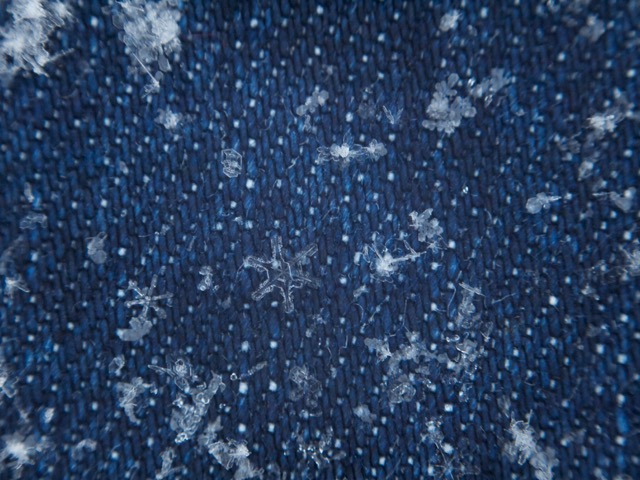The slow, inexorable approach of Christmas means that Christmas adverts are now increasing in frequency at an incredible rate. Nauseating John Lewis offerings aside, we are going to be seeing a lot of snowflake-based imagery over the next month and a half. But behind the stylistic snow crystals we see in TV adverts and on christmas cards, there is a fascinating science which is still full of many mysteries.
In the UK snowfalls are not particularly common. But we usually see one or two each winter here in Reading, and these can be a great opportunity to see what snowflakes really look like. Many people assume you need a microscope or expensive photographic equipment to see the shapes of snow crystals. In fact, you can very often see a lot of detail with the naked eye – just look carefully as they fall on your gloves or coat and you’ll be surprised.
Here’s an example of some snowflakes that fell in my back garden in January 2013:
You can see how beautiful and delicate these particles are — and also how complex. There are some crystals here which are recognisable as the classic 6-armed star-shaped crystals you might see on a Christmas card. But you can see many more which are much more three dimensional and irregular in nature. Why the variety?
Well, the biggest influence on a snowflake as it grows is temperature. This was first unravelled by the Japanese physicist Ukichiro Nakaya in the 1930s, who was the first to grow snowflakes artificially in a lab. He discovered that ice grows in dramatically different ways depending on what the temperature is. At -2 °C it forms small thin hexagons; go a few degrees colder to -5 °C and it forms long slender pencil-shaped crystals which are hollow in the centre. Go colder still to -15 °C and you get the classic six-arm stellar snowflakes we all know and love: these are often 100 times as wide as they are thick. A bit colder still at -25 °C or so and we get the complex particles you can see in the photo above: these are polycrystals, which means several individual plate-like crystals have sprouted from a single frozen water droplet.
So the shape of a snow crystal depends on the temperature at which it formed in the atmosphere. But of course this is often several kilometres above us in the atmosphere: so by the time they fall to earth they’ve been falling for a couple of hours. During this time they will have passed through a whole range of different temperatures, modifying the shape of the crystal as it grows. To complicate things further, as the crystals fall through the cloud they inevitably collide with each other, sticking together to form clusters. The closer the temperature is to 0 °C, the ‘stickier’ the surface of the ice gets – that’s why you get the really huge fluffy flakes when the temperature is close to the freezing: these big flakes are dozens and dozens of individual crystals stuck together.
So how can we possibly observe and understand this complicated evolution of snowflakes as they grow, fall and stick together? Well one way is using radar. Just as aircraft reflect radio waves, so believe it or not, do snowflakes. Our research group at the University of Reading uses the unique radar facilities at the Chilbolton Observatory in Hampshire to unravel the evolution of snowflakes as they fall through clouds, monitoring their shape, fall speed and number. This may seem a bit academic, after all many of us in the UK only get a few days with snowfall each year. But of course, even if the temperature at the ground is warmer than 0 °C, the temperature several kilometres above us is well below freezing. So clouds of snow crystals are above us throughout the year – it’s just that if they fall to earth, they melt into raindrops first. In fact, the majority of rain in the UK forms this way – by melting snow formed up high in the atmosphere. So if we want to forecast rainfall rate at the ground, we first need to predict the snowfall rate a few kilometres above us!
So next time you think “ … not another Christmas ad” – maybe you can at take a tiny bit of comfort in the little computer-generated snow crystal graphics in the background and think about the amazing journey that real ice crystals take as they grow and fall through the atmosphere.


